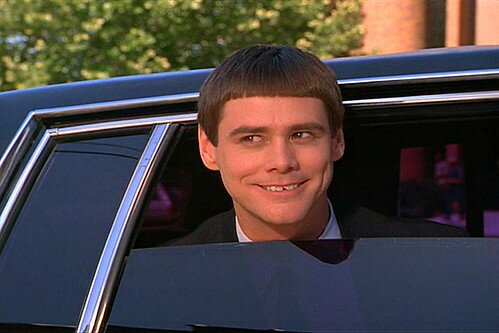

Writing this one is going to be difficult, because Mike Myers and Jim Carrey were larger than life heroes to me growing up as a proud ’90s Kid.
Nothing could be more important to 12-year-old Josh than a couple of smart-assed Canadians who were not only embraced, but loved for their brand of unapologetically strange comedy.
Who Framed Roger Rabbit established firmly that there were two polarities: humans and toons, and never shall the twain meet. (They tried that in Cool World and it ended very badly.) Until, of course, Carrey and Myers came along and obliterated any such distinctions. These guys were living cartoons, just barely tethered to reality itself. Jim could do things with his body and face that didn’t seem possible. Mike could say any random phrase and, magically, everyone would be repeating it.
I didn’t care that The Mask was severely toned down from its original comic book source. I didn’t care that the Austin Powers concept had run out of steam even before the second movie. I didn’t care that Batman Forever was a mess that did quite a bit to destroy everything that was cool about Batman, and, even though I should have known better by 2001, I didn’t care that Shrek was poorly animated meme fodder. To this day, when nobody is watching, I still quote lines from Ace Ventura to myself.
(Heck, I was doing it all the way through writing my William Shatner article! I’ve……GOT TO, MISTER!!)
Today, Carrey and Myers are cautionary tales. They are what happens when you push the boundaries of what is possible too far. When either of them can land a role, they serve as Nicolas Cage-esque objects of weirdness that nobody knows what to do with. When Quentin Tarantino cast Myers as a British army officer in Inglourious Basterds, I thought the gritty and over-the-top WWII revenge flick had turned into another Austin Powers movie.
I mentioned a few weeks ago that the secret to Norm MacDonald’s success is his carefully maintained average-guy act. Norm knows that you have to keep expectations low, otherwise, even highly impressionable kids like 12-year-old me will eventually get bored of your antics. Jim Carrey and Michael Myers never figured this out. They just kept on reaching.
Not satisfied with being paid $20 million per movie, Carrey decided he wanted to win an Oscar as a serious actor. Good biopics like Man On The Moon alternated with treacly sludge like The Majestic. For his part, Mike Myers decided he was going to recapitulate Peter Sellers’ race-lifting antics from The Party and pretend to be Indian in The Love Guru.
And, in what can’t be a coincidence, they both perpetrated cinematic crimes against Dr. Seuss. Again, some things just shouldn’t be messed with.
People forget that when Kanye West let loose with his jaw-dropping “George Bush Doesn’t Care About Black People” comment, a totally outclassed Mike Myers was standing right next to him. And today, Jim Carrey is barely noticeable as Dr. Robotnik, one of video gaming’s most iconic villains, in the upcoming Sonic The Hedgehog movie.
Is there some poetic justice in a horrifically rendered Sonic getting more attention than the guy who once actually talked out of his own butt on a movie screen? You tell me.
We’ll come full circle next week when we look at the most prominent Canadian, and one of the most successful leading men, in Hollywood today: Ryan Reynolds.
*****
See the previous installments in the series:
Part 1 on Heroes: ‘Scott Pilgrim Vs The World’ Vs Terrance Denby and ‘Sidequest’
Part 2 on “Humour”: The Libertarian Fantasy of ‘Letterkenny’
Part 3 on Graphic Novel Nihilism: The Harsh Truths of ‘Essex County’
Part 4 on Spawn and Wolverine: Banished From The Promised Land: A Tale of Two Canadian Anti-Heroes
Part 5 on Science Fiction Dystopias: Inside Quebec’s – and Canada’s – Replicant Culture
Part 6 on Animation: The Garrison Mentality: More Than Meets The Eye
Part 7 on Pop Music: How To Build A Successful Canadian Musical Act
Part 8 on Anne of Green Gables and The Traumatized Artist: Lucy Maud Montgomery’s Treacherous Alpine Path
Part 9 on Avoiding the Serious: Mordecai Richler, Montreal, And Gritty Realism
Part 10 on Southern Ontario Gothic: The Marriage of the Mundane and the Fantastic
Part 11 on Margaret Atwood’s Reign of Terror: Literary Tyranny and The Handmaid’s Tale
Part 12 on the First Nations Fraud: Whitewashing Genocide: Truth, Lies, and Joseph Boyden
Part 13 on the inventive Esi Edugyan: A Novel I Cannot Recommend Enough
Part 14 on Generation X Origins: Douglas Coupland And The Hopeful (?) Future Of Canadian (?) Culture
Part 15 on Jordan Peterson Rising: Canadian Culture Creators And The Intellectual Dark Web
Part 16 on The Awkward Quiet: David Cronenberg’s Silent Hell
Part 17 on The Saddest Music In The World: Guy Maddin’s Surrealist Madness
Part 18 on Ararat: Atom Egoyan’s Stammering Grief
Part 19 on Paul Haggis’ Superficial Gloss: Promising More Than He Delivers
Part 20 on the Reitman Family’s Blissful Ignorance: Space to Laugh an Easy Laugh
Part 21 on Mary Pickford: The Archetypal (Canadian) Actress
Part 22 on the Modern Prospero Christopher Plummer: As Blue-Blooded and Upper Canadian as They Come
Part 23 on Donald Sutherland: Grit Personified
Part 24 on Leslie Nielsen: The Funniest Thing in a Movie Where Jokes are Delivered Almost Every Minute
Part 25 on William Shatner: Faking It Until He Made It
Part 26 on The Trouble of “Story”: Story Wars: Canadians and the Star Trek vs. Star Wars Battle
Part 27 on Norm MacDonald’s Controlled Chaos: The Holy Fool Personified
Part 28 on the Culture of Newfoundland and Labrador: Long May Your Big Jib Draw!
*****
Photos by twm1340,
Photo by twm1340 
Photo by ellasportfolio 
Photo by Bigotes de Gato | Fotografía 
Photo by Luke Rauscher 



Comments